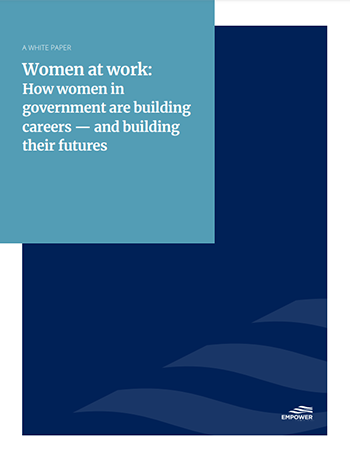Women at work
Women at work
Women at work

How women in government are building careers ― and their futures
How women in government are building careers ― and their futures
From preparing for retirement to gaining equal compensation to raising their families, women are juggling many priorities while on the job. In fact, although women make up more than half of the current workforce in the public sector in the U.S., they typically earn less than men and hold fewer high-level positions.1
With women continuing to overcome financial obstacles in today’s world, Empower recently talked to eight of its government partners to see how their female leaders are going above and beyond in their professions.
Through our interviews, women government leaders shared how they and their agencies are addressing key issues head-on. They shared numerous stories that bring to life how women’s roles as well as their representation, career advancement, and overall financial well-being in the workplace are evolving. We clearly heard that women are:
Breaking barriers. Slowly but surely women are advancing, but their representation in leadership varies widely depending on the agency and job function.
Leveling the playing field. While more women are blazing trails, they are still lagging their male counterparts in the public segment from an income perspective. Despite the overall pay gap, the public sector leaders we spoke with agreed that established salary bands and transparency tied to public sector roles are helping to narrow existing differences. They also felt that the gender pay gap in the public sector was less pronounced than in the private sector.
Wearing many hats. In the 1950s, less than 35% of moms participated in the workforce. Today, that number has more than doubled as more mothers with children under the age of 18 are pursuing their passions and establishing careers.2 But just because more moms are choosing to work doesn’t mean their caregiving obligations are going away. However, a growing work-life balance that may include working from home, hybrid schedules, or virtual meetings is helping women thrive and succeed in all areas.
Saving — and paving — the way. In the public sector alone, women have lower average retirement savings rates than men. Income, access to a pension, and lack of financial confidence can play a role in overall outcomes. But for government participants on the Empower recordkeeping platform, women are socking away 0.80% less than their male counterparts. That figure jumps to more than a 1% difference for participants making under $60,000.3
Focusing on the future. By and large, women don’t appear to be as engrossed in their retirement planning as men are in some respects. Our research finds that women are overall slightly less engaged than men in terms of interacting with their retirement planning.4 Although men and women share similar retirement goals and needs, how they solve and approach them may vary. A common female-centric learning theme resonated throughout our discussions as being an important way to engage women and help them prepare for retirement.
Taking action: Improving the retirement readiness of women employees
When it comes to retirement planning, men and women share many of the same needs in terms of engagement, education, advice, and overall support. However, there are key differences regarding how women approach their finances, how they prefer to engage, and how they prioritize saving, among others.
Below are some key takeaways and concepts from our interviews that can help support the retirement readiness and financial well-being of women employees.
|
What we heard |
Challenge |
Way forward |
|
A caregiving mindset |
Women are more likely to put their family or loved ones’ financial needs ahead of their own. |
It’s important to communicate the importance of prioritizing women’s own financial and retirement needs and not postponing or reducing their retirement savings for other goals such as paying off a child’s college education or assisting them in the purchase of a home. |
|
A sense of community |
Women are often uncomfortable tackling retirement planning and financial topics. |
Employee resource groups or other affinity groups can create a safe place for women to learn and talk about managing their finances. Sponsoring retirement planning or financial planning meetings through these groups can help build financial confidence and kick-start greater engagement. |
|
Traditional household finance roles |
It’s common for women to defer their financial planning to their spouse or partner. |
Encourage women to take an active role in their planning. That’s especially important considering that women are likely to outlive their partners. |
|
Advice with empathy |
Many women aren’t comfortable receiving advice from a male financial professional. They often feel that men don’t listen to them or don’t understand their personal situations. |
It may not always be possible to make female financial representatives available, but it should be a priority to ensure that representatives can empathize with women and their concerns. |
|
A deeper employee understanding |
There is no such thing as a one-size-fits-all approach to meeting women’s retirement readiness needs. |
Comparing key pay, census, and retirement savings metrics by gender is an important starting point to identify opportunities to support women. But it’s also important to look at just women employees across a variety of metrics such as income, age, or investment usage to uncover even more opportunities. |
Download the white paper to learn more about how women are building their futures in the public sector.
1 The Guardian, “Women earn 10% less than men in America's public sector, analysis shows,” February 2018.
2 U.S. Bureau of Labor Statistics, “Labor force participation of mothers and fathers little changed in 2021, remains lower than in 2019,” April 2022.
3 Analysis of government supplemental defined contribution participants with Empower as a recordkeeper as of 12/31/2022.
4 Ibid.
WF-2416850-0323 RO2750211-0323





